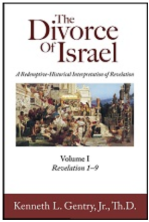PRETERISM IN REVELATION (1)
 PMW 2024-054 by Kenneth L. Gentry, Jr.
PMW 2024-054 by Kenneth L. Gentry, Jr.
In light of the release (finally!) of my commentary on Revelation, I thought it might be helpful to introduce four basic principles that provide exegetical justification for preterism therein. Many are unfamiliar with the preterist understanding of Revelation. These justifications are rooted in interpretive demands derived from the text itself, not from theological predispositions (e.g., anti-premillennialism) or from traditional predilections (e.g., John Lightfoot emulation). By doing this, I hope these articles might be a brief “tract” to help introduce family and friends to this very different approach than that held by Hal Lindsey and Tim LaHaye.
The leading preterist evidence derives from John’s temporal delimitations, which he emphasizes by strategic placement, didactic assertion, frequent repetition, and careful variation.
He strategically places them twice in his introduction (1:1, 3) and five times in his conclusion (22:6, 7, 10, 12, 20), thereby bracketing the highly wrought drama within (4:1–22:6). In these didactic passages John employs two terms demanding preterism: tachos / tachu (1:1, cp. 22:7, 12, 20) and eggus (1:3; cp. 22:10). For example:
The Revelation of Jesus Christ, which God gave Him to show to His bond-servants, the things which must shortly [tachos] take place. . . . Blessed is he who reads and those who hear the words of the prophecy, and heed the things which are written in it; for the time is near [eggus]. (1:1a, 3)
The Divorce of Israel: A Redemptive-Historical Interpretation of Revelation
This long-awaited commentary has now been published. It is an 1800 page, two-volume deeply exegetical, academic commentary on the Bible’s most mysterious book.
See more study materials at: www.KennethGentry.com
John immediately impresses upon his reader the nearness of his prophetic events.
Lexicographers agree on the temporal significance of tachos in Revelation: The Baur-Arndt-Gingrich-Danker Lexicon (BAGD) notes that en tachei means: “soon, in a short time Lk 18:8; Ro 16:20; 1 Ti 3:14 v.1; Rv 1:1; 22:6; 1 Cl 65:1; shortly Ac 25:4.” Thayer offers the following range of meanings: “quickness, speed and quickly, shortly, speedily, soon,” listing Revelation 1:1 and 22:6 with the “speedily, soon” entries. Abbott-Smith concurs: 1:1 and 22:6 mean “quickly, speedily, soon.” Greek text editors F. J. A. Hort, Kurt Aland, and Howard Marshall agree. Hort translates it “shortly, soon.” Kurt Aland comments: “In the original text, the Greek work used is tachu, and this does not mean ‘soon,’ in the sense of ‘sometime,’ but rather ‘now,’ immediately.” Howard Marshall cites Revelation 1:1 and 22:6 as evidence that the normal use of the phrase en tachei “suggest[s] that soon is the meaning.”
In fact, all English versions translate it either as: “soon” (NIV, RSV, Beck, NRSV, NAB, CEV), “shortly” (KJV, ASV, Weymouth, NEB, NASB, NKJV), or “very soon” (Moffatt, Phillips, Williams, TEV). Tachos obviously indicates temporal brevity elsewhere (e.g., Lk 18:8; Ac 12:7; Ro 16:20). The same is true of its related form tachus (Mt 5:25; Mk 9:39; Lk 15:22; cp. Rev 2:16; 3:11; 11:14; 22:7, 12, 20).
This evidence is reinforced by John’s linking tachos with eggus in the same contexts, as if to provide a two-fold witness (1:1, 3; 22:6, 10). BAGD provides the following entry for eggus: “of time near a. of the future: kairos Mt 26:18; Rv 1:3; 22:10.” The other lexicons cited above concur. TDNT notes that the term means “temporally near at hand” and observes that “like the Synpt., Rev. uses eggus only as a term for the near coming of the kingdom of God. Thus we have ho gar kairos eggus in 1:3; cf. 22:10″ (3:330, 331). The various samples of eggus in the NT all agree: some relating spatial, others temporal nearness (Mt 24:32, 33; 26:18; 13:28, 29; Lk 19:11; 21:30, 31). And again, all translations of Revelation agree; all versions cited above have either “near” or “at hand.”
BEFORE JERUSALEM FELL
Doctoral dissertation defending a pre-AD 70 date for Revelation’s writing (459 pp; paperback). Thoroughly covers internal evidence from Revelation, external evidence from history, and objections to the early date by scholars.
For more study materials: https://www.kennethgentry.com/
Perhaps the most interesting proof of the meaning of these terms is the various competing, innovative, counter-intuitive attempts to get around their obvious significance! Indeed, if these terms do not express temporal nearness, what terms could John have used to do so? I am firmly convinced John prophesies the fast approaching destruction of the Temple in A.D. 70.
But there is more! See you next time.
The Reformed Eschatology of Geerhardus Vos
Ed. by Ken Gentry and Bill Boney
This collection of several key eschatological studies by the renowned theologian Geehardus Vos will be published in late Summer or early Fall 2024. We have modernized Vos’ grammar and syntax and updated his publications according to modern style conventions (shorter sentences and paragraphs).
For information on the upcoming Geerhardus Vos work, see:
https://axeheadpress.com/pages/coming-soon-vos
Kenneth L. Gentry Jr.'s Blog
- Kenneth L. Gentry Jr.'s profile
- 85 followers



